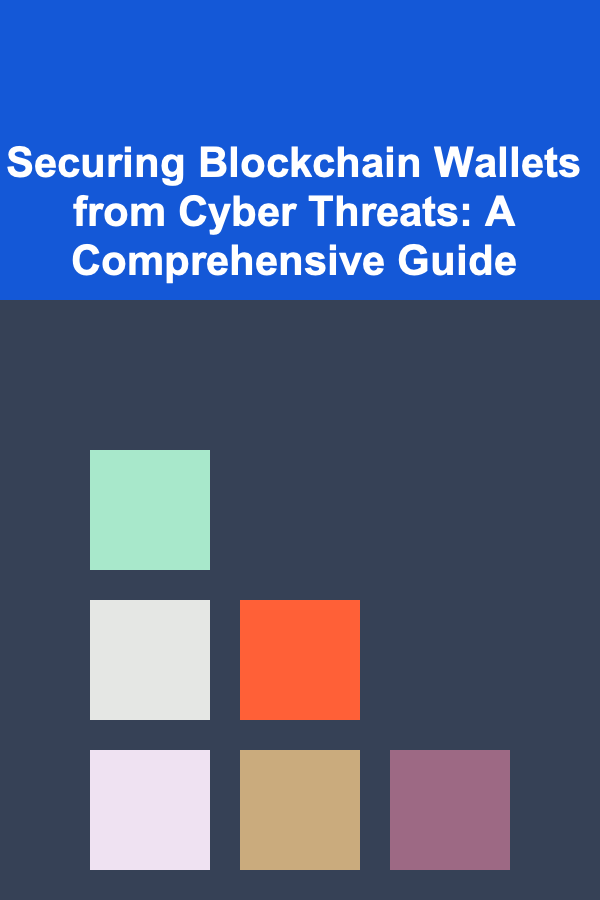
Securing Blockchain Wallets from Cyber Threats: A Comprehensive Guide
ebook include PDF & Audio bundle (Micro Guide)
$12.99$7.99
Limited Time Offer! Order within the next:

Blockchain technology, renowned for its decentralized and immutable nature, has revolutionized various sectors, from finance and supply chain management to healthcare and voting systems. At the heart of this revolution are blockchain wallets, the digital gateways that allow users to interact with and manage their digital assets. However, the increasing popularity and value associated with cryptocurrencies and other blockchain-based assets have made blockchain wallets prime targets for cybercriminals. Understanding the threats and implementing robust security measures is crucial to safeguarding your digital wealth.
Understanding the Threat Landscape
Before diving into security strategies, it's essential to grasp the diverse array of cyber threats that target blockchain wallets. These threats are constantly evolving, requiring continuous vigilance and adaptation.
1. Phishing Attacks
Phishing remains one of the most prevalent and effective attack vectors. Cybercriminals employ deceptive tactics, such as emails, websites, and social media posts, to impersonate legitimate entities (e.g., wallet providers, cryptocurrency exchanges) and trick users into revealing their private keys, seed phrases, or login credentials. These attacks often exploit human psychology, creating a sense of urgency or fear to bypass users' critical thinking.
Example: A user receives an email purportedly from their wallet provider, claiming that their account has been compromised and requires immediate verification. The email directs the user to a fake website that mimics the genuine login page. Unsuspecting users who enter their credentials unknowingly hand over their account access to the attacker.
2. Malware and Keyloggers
Malware, including keyloggers, trojans, and ransomware, poses a significant threat to blockchain wallet security. Keyloggers, in particular, are designed to record every keystroke made by the user, capturing sensitive information such as passwords, seed phrases, and private keys. This malware can be distributed through various means, including malicious websites, infected software downloads, and email attachments.
Example: A user downloads a seemingly legitimate software program from an untrusted source. Unbeknownst to the user, the software contains a keylogger that silently records their keystrokes. When the user enters their wallet password or seed phrase, the keylogger captures this information and transmits it to the attacker.
3. Social Engineering
Social engineering exploits human trust and vulnerabilities to gain unauthorized access to blockchain wallets. Attackers may impersonate support staff, fellow investors, or even family members to manipulate users into divulging sensitive information or performing actions that compromise their wallet security. These attacks often rely on building rapport and trust with the victim before launching the actual attack.
Example: An attacker poses as a technical support representative from a cryptocurrency exchange. They contact a user claiming that their account has been flagged for suspicious activity and requires immediate verification. The attacker then guides the user through a series of steps that ultimately lead to the user revealing their private key or seed phrase.
4. Man-in-the-Middle (MITM) Attacks
Man-in-the-Middle attacks involve intercepting communication between the user and the blockchain network or wallet provider. Attackers position themselves between the user and the intended recipient, eavesdropping on the communication and potentially manipulating the data being exchanged. This can allow attackers to steal credentials, modify transactions, or even redirect funds to their own wallets.
Example: A user connects to a public Wi-Fi network to access their blockchain wallet. An attacker on the same network intercepts the communication between the user's device and the wallet provider's servers. The attacker then steals the user's login credentials or modifies the transaction details, redirecting the funds to their own account.
5. 51% Attacks (for Proof-of-Work Blockchains)
While not a direct wallet attack, a 51% attack on a Proof-of-Work (PoW) blockchain can indirectly compromise wallet security. If an attacker gains control of more than 50% of the network's mining power, they can manipulate the blockchain, potentially double-spending coins and reversing transactions. This can lead to financial losses for wallet holders who unknowingly receive or send funds during the attack.
6. Vulnerabilities in Smart Contracts
For wallets that interact with decentralized applications (dApps) built on smart contracts, vulnerabilities in the smart contract code can pose a significant risk. Attackers can exploit these vulnerabilities to drain funds from wallets or manipulate the contract's logic to their advantage. Common smart contract vulnerabilities include reentrancy attacks, integer overflows, and unauthorized access control.
7. SIM Swapping
SIM swapping is a form of identity theft where attackers convince a mobile carrier to transfer a victim's phone number to a SIM card controlled by the attacker. This allows the attacker to intercept SMS-based two-factor authentication codes, gaining access to the victim's accounts, including blockchain wallets. This is particularly dangerous when the wallet uses SMS 2FA.
8. Insider Threats
While often overlooked, insider threats can be devastating. Employees or contractors with access to wallet infrastructure or user data can intentionally or unintentionally compromise security. This could involve stealing private keys, modifying transaction records, or providing attackers with privileged access to the system.
Implementing Robust Security Measures
Protecting your blockchain wallet from cyber threats requires a multi-layered approach, encompassing both technical safeguards and user education. Here's a comprehensive guide to securing your digital assets:
1. Choosing the Right Wallet Type
The type of wallet you choose significantly impacts its security. There are several types of wallets available, each with its own trade-offs between security and convenience:
- Hardware Wallets: These are physical devices that store your private keys offline, providing the highest level of security. They are typically connected to your computer or mobile device only when you need to make a transaction. Ledger and Trezor are popular hardware wallet brands.
- Software Wallets (Desktop/Mobile): These wallets are installed on your computer or mobile device. While more convenient than hardware wallets, they are also more vulnerable to malware and other cyber threats. Electrum and Exodus are examples of popular software wallets.
- Web Wallets: These wallets are accessed through a web browser. They are the most convenient option but also the least secure, as your private keys are stored on a third-party server. Consider using web wallets only for small amounts of cryptocurrency.
- Paper Wallets: A paper wallet is simply a printout of your public and private keys. While providing offline storage, they are susceptible to physical damage, loss, and require careful handling during the process of key generation and transaction signing (often involving complex offline software). They are generally not recommended for everyday use.
Recommendation: For long-term storage of significant amounts of cryptocurrency, a hardware wallet is strongly recommended. For smaller amounts used for daily transactions, a software wallet with strong security practices may be sufficient.
2. Strong Password Management
A strong and unique password is the first line of defense against unauthorized access to your wallet. Here are some essential password management practices:
- Create Strong Passwords: Use passwords that are at least 12 characters long and include a mix of uppercase and lowercase letters, numbers, and symbols.
- Use Unique Passwords: Never reuse the same password for multiple accounts, including your blockchain wallet.
- Use a Password Manager: A password manager can securely store and generate strong, unique passwords for all your accounts. Popular options include LastPass, 1Password, and Bitwarden.
- Enable Two-Factor Authentication (2FA): 2FA adds an extra layer of security by requiring a second verification factor, such as a code generated by an authenticator app (Google Authenticator, Authy) or a hardware security key (YubiKey), in addition to your password. Avoid SMS-based 2FA due to the risk of SIM swapping.
- Regularly Update Passwords: Change your passwords periodically, especially if you suspect your account has been compromised.
3. Secure Seed Phrase Storage
Your seed phrase (also known as a recovery phrase or mnemonic phrase) is a list of 12 or 24 words that allows you to recover your wallet in case you lose access to it. Treat your seed phrase as the master key to your digital wealth.
- Store Your Seed Phrase Offline: Never store your seed phrase digitally on your computer, mobile device, or in the cloud. Instead, write it down on a piece of paper and store it in a secure location.
- Consider Metal Seed Phrase Backup: For long-term storage, consider using a metal seed phrase backup solution. These devices are resistant to fire, water, and other forms of damage.
- Avoid Sharing Your Seed Phrase: Never share your seed phrase with anyone, even if they claim to be from your wallet provider or a cryptocurrency exchange. No legitimate entity will ever ask for your seed phrase.
- Divide and Conquer (Shamir's Secret Sharing): For extreme security, consider splitting your seed phrase into multiple parts using a method like Shamir's Secret Sharing (SSS). You can then store these parts in different secure locations, requiring a certain number of parts to reconstruct the original seed phrase.
Remember to test your seed phrase backup periodically to ensure that you can successfully recover your wallet.
4. Secure Your Computing Environment
The security of your blockchain wallet is directly related to the security of your computing environment. Take the following steps to protect your computer and mobile devices:
- Install Antivirus and Anti-Malware Software: Use reputable antivirus and anti-malware software and keep it up to date. Regularly scan your system for threats.
- Keep Your Operating System and Software Up to Date: Software updates often include security patches that address known vulnerabilities.
- Use a Firewall: A firewall can help prevent unauthorized access to your computer.
- Avoid Suspicious Websites and Downloads: Be cautious when browsing the internet and downloading files from untrusted sources.
- Use a Virtual Private Network (VPN): A VPN encrypts your internet traffic, protecting it from eavesdropping. This is especially important when using public Wi-Fi networks.
- Enable Full Disk Encryption: Encrypting your hard drive prevents unauthorized access to your data if your computer is lost or stolen. Both Windows and macOS have built-in encryption tools (BitLocker and FileVault, respectively).
- Use a Dedicated Device for Cryptocurrency Transactions: Consider using a dedicated computer or mobile device solely for cryptocurrency-related activities. This can help reduce the risk of malware infection.
5. Be Vigilant Against Phishing Attacks
Phishing attacks are constantly evolving, so it's crucial to be vigilant and skeptical of unsolicited emails, messages, and websites. Here are some tips for avoiding phishing scams:
- Verify the Sender's Identity: Carefully examine the sender's email address or website URL. Look for subtle misspellings or variations that may indicate a phishing attempt.
- Be Wary of Urgent Requests: Phishing emails often create a sense of urgency or fear to pressure you into taking immediate action.
- Never Click on Suspicious Links: Avoid clicking on links in emails or messages from unknown senders. Instead, type the website address directly into your browser.
- Verify Information Through Official Channels: If you receive a suspicious email or message, contact the organization directly through their official website or customer support channels to verify the information.
- Use a Phishing Filter: Many email providers offer phishing filters that can help detect and block phishing emails.
- Educate Yourself and Others: Stay informed about the latest phishing tactics and share this information with your friends and family.
Always double-check the transaction details before signing a transaction. Pay close attention to the recipient's address and the amount being sent. Most hardware wallets and software wallets provide a clear confirmation screen to review these details.
6. Secure Your API Keys (for Trading Bots and Automated Transactions)
If you use trading bots or other automated systems that require access to your cryptocurrency exchange accounts, you'll need to generate API keys. API keys provide programmatic access to your account, allowing these systems to execute trades and manage your funds. Securing your API keys is paramount.
- Limit API Key Permissions: When generating API keys, grant only the minimum necessary permissions. For example, if the bot only needs to execute trades, disable withdrawal permissions.
- Use IP Whitelisting: Restrict API key access to specific IP addresses. This prevents unauthorized access from other locations.
- Monitor API Key Usage: Regularly monitor your API key usage for any suspicious activity.
- Store API Keys Securely: Store your API keys in a secure location, such as a password manager or encrypted file. Avoid storing them in plain text.
- Rotate API Keys Regularly: Change your API keys periodically to minimize the impact of a potential breach.
- Disable Unused API Keys: If you're no longer using an API key, disable it immediately.
7. Secure Your Mobile Device
If you use a mobile wallet, it's essential to secure your mobile device from malware and unauthorized access.
- Enable a Strong Passcode or Biometric Authentication: Use a strong passcode or biometric authentication (fingerprint or facial recognition) to protect your device from unauthorized access.
- Keep Your Mobile Operating System and Apps Up to Date: Software updates often include security patches that address known vulnerabilities.
- Install Antivirus Software (Optional): While not always necessary, installing reputable antivirus software on your mobile device can provide an extra layer of protection.
- Be Cautious When Installing Apps: Only download apps from official app stores (Google Play Store or Apple App Store). Carefully review app permissions before installing.
- Disable Location Services: Disable location services for apps that don't need them.
- Use a VPN When Connecting to Public Wi-Fi: A VPN encrypts your internet traffic, protecting it from eavesdropping.
- Enable Remote Wipe and Lock: Enable remote wipe and lock features on your device. This allows you to remotely erase your data if your device is lost or stolen.
8. Regular Audits and Security Assessments
Conducting regular security audits and assessments of your blockchain wallet setup can help identify potential vulnerabilities and weaknesses. This can involve reviewing your security practices, testing your defenses, and seeking expert advice from security professionals.
- Review Your Security Practices: Periodically review your security practices to ensure that they are up to date and effective.
- Test Your Defenses: Conduct simulated attacks to test your defenses and identify any weaknesses.
- Seek Expert Advice: Consult with security professionals to get expert advice on securing your blockchain wallet.
9. Be Aware of Dusting Attacks
A "dusting attack" involves attackers sending small amounts of cryptocurrency (known as "dust") to numerous wallets. The goal is to de-anonymize the wallet owners by tracking the movement of these small amounts of crypto as they are later spent. While not directly stealing funds, it can compromise privacy and potentially lead to targeted phishing or extortion attempts.
- Be Aware of Unexpected Transactions: Pay attention to any unexpected small transactions in your wallet.
- Avoid Spending the Dust: If you receive dust, avoid spending it. Leaving it untouched prevents the attacker from tracking its movement.
- Consider Using Coin Control Features: Some wallets offer "coin control" features that allow you to choose which inputs (UTXOs) to use when making a transaction. This allows you to avoid including the dust in your transactions.
- Use Privacy-Focused Wallets: Consider using wallets that offer enhanced privacy features, such as coin mixing or CoinJoin, to further obscure transaction histories.
10. Keep Your Wallet Software Up to Date
Wallet software updates often include critical security patches that address newly discovered vulnerabilities. Always install updates promptly to protect your wallet from known exploits.
Conclusion
Securing blockchain wallets from cyber threats is an ongoing process that requires constant vigilance and adaptation. By understanding the threat landscape and implementing robust security measures, you can significantly reduce the risk of losing your digital assets. Remember that no security measure is foolproof, and it's essential to stay informed about the latest threats and best practices. Prioritize the security of your seed phrase, use strong passwords and two-factor authentication, secure your computing environment, and be vigilant against phishing attacks. By taking these precautions, you can confidently navigate the world of blockchain and protect your digital wealth.

How to Organize Your Bath Toys for Kids
Read More
How To Select the Right Lighting for Every Room
Read More
How to Use Furniture with Hidden Storage Features
Read More
How to Use Shelving Units for Storing Instruments
Read More
How to Develop a Strong Sense of Identity
Read More
10 Tips for Mastering the Art of Pie Crust
Read MoreOther Products

How to Organize Your Bath Toys for Kids
Read More
How To Select the Right Lighting for Every Room
Read More
How to Use Furniture with Hidden Storage Features
Read More
How to Use Shelving Units for Storing Instruments
Read More
How to Develop a Strong Sense of Identity
Read More